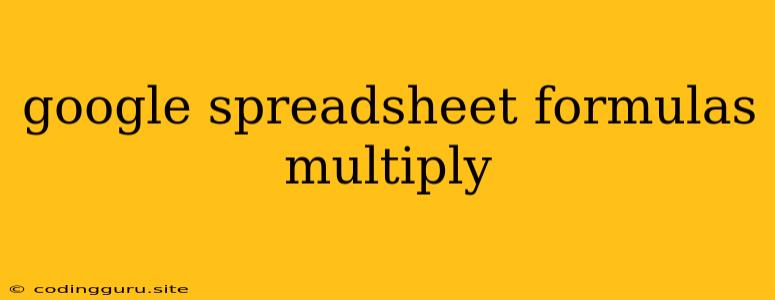Mastering Multiplication in Google Sheets: A Guide to Essential Formulas
Google Sheets is a powerful tool for data analysis and management, and its built-in formulas are key to unlocking its full potential. Multiplication, a fundamental mathematical operation, is often needed when working with spreadsheets, and Google Sheets provides several formulas to make the process efficient and accurate.
Why Use Formulas for Multiplication in Google Sheets?
Formulas offer several advantages over manual multiplication:
- Efficiency: Multiplying large datasets manually is tedious and prone to errors. Formulas automate the process, saving time and effort.
- Consistency: Formulas ensure all calculations are performed using the same method, eliminating inconsistencies.
- Dynamic Updates: When data changes, formulas automatically recalculate, keeping your results up-to-date.
Essential Multiplication Formulas in Google Sheets
1. The * Operator:
The simplest way to multiply in Google Sheets is using the asterisk (*) operator. This works just like a standard calculator:
Example: To multiply the value in cell A1 by the value in cell B1, use the formula =A1*B1.
2. The PRODUCT Function:
The PRODUCT function multiplies a range of cells together.
Example: To multiply the values in cells A1 to A5, use the formula =PRODUCT(A1:A5).
3. The SUMPRODUCT Function:
This versatile function performs a sum of products between corresponding cells in two or more ranges.
Example: To multiply the values in cell A1, B1, and C1, and then sum the results, use the formula =SUMPRODUCT(A1:C1).
4. Multiplying by a Constant:
To multiply a range of cells by a constant value, you can use the * operator or incorporate the constant directly within a function.
Example: To multiply the values in cells A1 to A5 by 2, use the formula =A1:A5*2 or =PRODUCT(A1:A5,2).
Tips for Using Google Sheets Multiplication Formulas
- Referencing Cells: Always reference cells using their addresses, like
A1,B2, etc. - Using Ranges: Ranges like
A1:A5refer to a group of cells. - Order of Operations: Remember the order of operations (PEMDAS/BODMAS) when combining multiplication with other operations.
- Error Handling: Use
IFERRORorIFNAfunctions to handle errors that may occur during multiplication.
Solving Common Multiplication Challenges
1. Multiplying Only Certain Cells:
If you only need to multiply certain cells within a range, use the SUMPRODUCT function with a condition.
Example: To multiply only the values in cells A1 to A5 that are greater than 10, use the formula =SUMPRODUCT((A1:A5>10)*A1:A5).
2. Multiplying Based on Multiple Criteria:
For more complex multiplication scenarios involving multiple conditions, you can use the SUMIFS or SUMPRODUCT functions with multiple criteria.
Example: To multiply only the values in cells A1 to A5 that are greater than 10 and less than 20, use the formula =SUMPRODUCT((A1:A5>10)*(A1:A5<20)*A1:A5).
3. Multiplying Cells in Different Sheets:
To multiply cells in different sheets, use the sheet name followed by an exclamation mark before the cell reference.
Example: To multiply the value in cell A1 in sheet "Sheet1" by the value in cell B1 in sheet "Sheet2", use the formula =Sheet1!A1*Sheet2!B1.
Conclusion
Google Sheets offers a variety of formulas for efficient and accurate multiplication. From basic operations with the * operator to more advanced functions like SUMPRODUCT, you can choose the best method depending on your needs. Understanding these formulas will empower you to analyze and manipulate your data with ease, unlocking the full potential of Google Sheets for your projects.
